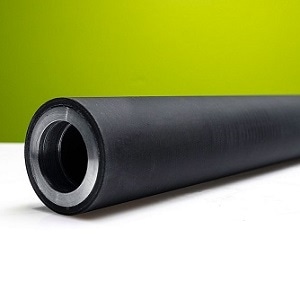Graphene nanotube-reinforced anti-static polyurethane shafts are becoming the new industry standard and help manufacturers keep production costs down and ensure occupational safety. Introducing as little as 0.03% of nanotubes is sufficient to impart uniform anti-static properties to polyurethane while maintaining its key properties.
 Antistatic shaft with graphene nanotubes
Antistatic shaft with graphene nanotubes
Switch to Anti-static Polyurethane
Graphene nanotubes are one of the most advanced conductive additives. They are widely used in polyurethanes in the production of shafts and rollers for various industries. High performance characteristics and stable anti-static properties of shafts with nanotubes make them the new industry standard.
Static electricity accumulation threatens industrial facilities equipped with production or transportation lines. The friction between a conveyor belt and the shaft that sets it in motion results in near-constant generation of electrostatic charge that can lead to a halt in production. Adhesion of such materials as fabric and film or a paper jam can also be responsible for a production line stoppage and related loses.
Another problem created by the static charge is adherence of dust. This increases the rejection rate when handling white or light-colored articles, for example, fabric, fiber or packaging. In addition, workers are constantly exposed to unpleasant electric shocks.
Preventing the Occurrence of Rejection
These problems lead a growing number of manufacturers to switch to anti-static polyurethane. To impart anti-static properties to a nonconductive polymer, conductive fillers must be added during the material manufacturing process. Until recently, carbon black and special mineral/organic fillers were typically used as a conductive additive. However, the required high concentrations of these additives in the range of 10–15% of the total weight of the material lead to a loss of strength and reduced life cycle of products.
Less Concentration Required
When used in polyurethanes as an anti-static additive, graphene nanotubes demonstrate outstanding results. In order to obtain volume resistivity within the range of 109–104 Ω·cm, it is sufficient to add graphene nanotubes in a working concentration that is 100 times less than that of ammonium salts and 500 times less than that of carbon black. Moreover, graphene nanotubes provide a wider range of resistance levels as compared to ammonium salts. Unlike carbon black, they achieve uniform distribution in materials, preserve the original physical and mechanical properties and leave no black “smearing” traces on the surface of output products (fabric, paper, film, etc.) thus preventing the occurrence of rejects.
Prevents Dust Gathering
The conductivity level obtained with the help of nanotubes neither degrades over time nor depends on humidity or temperature. This is especially important for industrial shafts, as they operate under conditions of continuous friction heating. Nanotubes also prevent dust gathering on equipment.
0.3 wt.% of TUBALL MATRIX Nanotube-based Concentrate
A concentrate of pre-dispersed graphene nanotubes recently developed by OCSiAl has made it possible to overcome the difficulties previously associated with the distribution of nanotubes in polyurethane systems and is already being successfully applied in industrial productions.
By introducing as little as 0.3 wt.% of TUBALL MATRIX nanotube-based concentrate when manufacturing polyurethane shafts, Unikom-Service Research & Production Company, a Russian enterprise, succeeded in manufacturing products with permanent and stable anti-static properties in the range of 109–107 Ω·cm.
This also enabled them to manufacture products with electrical conductivity properties and resistance values in the range of 107–105 Ω·cm that do not have “hot spots” while retaining important strength characteristics.
Unikom-Service has developed technologies for producing anti-static polyurethane materials with a wide range of hardness: from Shore A hardness of 60 units to Shore D hardness of 70 units and on different bases such as TDI, MDI, NDI.
A Russian manufacturer of polyurethane shafts for winding wool fiber is another successful example. They use 0.5 wt.% of pre-dispersed nanotube concentrate to achieve a uniform and stable surface resistivity level of 108 Ω/sq.
TUBALL graphene nanotubes manufactured by OCSiAl find a growing number of applications in the polyurethane market. They are already used in the production of industrial wheels, rollers and scraper pigs for various industries. Due to their high performance, these products are in high demand in the industry.